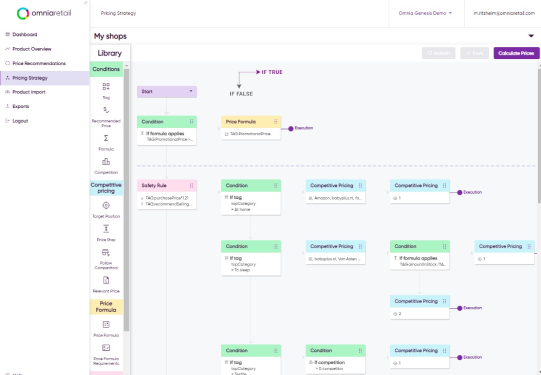How you price your products defines how you compete. Dynamic pricing software gives you the tools to move with the market and react to shifts in supply, demand, and competition. But before you get there, you need the right setup.
That starts with a clear, well-written RFP.
An RFP gives shape to your pricing goals. It helps you define what matters, align internally, and filter out solutions that won’t scale. It saves time in the long run and leads to stronger conversations with vendors.
At Omnia Retail, we’ve spent over a decade helping companies roll out dynamic pricing at scale. This guide shares what we’ve learned about writing an RFP that leads to better outcomes, from vendor selection to long-term success.
Understanding Your Business Needs
.png?width=726&height=408&name=RFP%20Blog%20Post%20(1).png)
Before drafting your RFP, it's important to build a clear picture of where your pricing organization stands today and where you want it to go. An RFP grounded in a real business context not only improves internal alignment but also makes it easier to identify a solution that fits your needs now and into the future.
A. Evaluate your current pricing capabilities
Start by asking the tough, yet important, questions:
- Do you have a good overview of the market already?
- If so, how confident are you in the accuracy and freshness of your pricing data?
- Do your teams rely on manual processes like Excel sheets or fragmented tools to set prices?
- Can you trace back how a price was calculated, or do pricing decisions feel vague?
By examining your current state, you’ll uncover where the bottlenecks lie: maybe it's the inability to respond quickly to price changes in the market, or a lack of transparency that makes it hard to explain decisions internally. These pain points will help you define the needs that need to be addressed in your future solution.
B. Define strategic goals and success metrics
Dynamic pricing is not a one-size-fits-all concept. Depending on your business model, category strategy, and market position, your objectives may differ:
- Gaining speed in reacting to market changes
- Improving margins without sacrificing competitiveness
- Scaling your pricing strategy across multiple teams or regions
Make these ambitions clear in your RFP. This will allow vendors to demonstrate how their platform adapts to your specific goals, not just how it works out of the box.
C. Bring the right stakeholders into the room
Dynamic pricing software often touches multiple departments, from category management, e-commerce, and marketing to finance and IT. Involving these stakeholders early ensures that the RFP reflects operational realities and reduces friction later in the buying process. For more information about selecting the right Pricing Software, read this guide for retailers and brands.
Ask each team:
- What challenges do they face with current pricing tools?
- What visibility do they need over pricing rules and outcomes?
- Who will be working with the new pricing platform and how often?
- How do they envision interacting with a new platform?
Also, consider the importance of ease of use and the learning curve. Pricing is too important to be limited to just a handful of specialists. Your RFP should encourage responses that support accessibility across your organization.
Key Components of an Effective RFP
.png?width=726&height=405&name=_-%20visual%20selection%20(2).png)
With your internal objectives mapped out, it’s time to translate them into a structured RFP that helps you evaluate the technology and the partnership behind it. A strong RFP goes beyond listing technical requirements, it creates a foundation for finding a solution that aligns with your pricing strategy, your organization, and your long-term vision.
Start with a short company overview. Vendors will benefit from understanding your market positioning, product categories, and pricing maturity.
Next, describe the pricing functionalities you’re looking for, not just in terms of “what” the system should do, but also how your teams will use it. If your current tools make it difficult to manage complex strategies or require technical support for every change, you’ll want to focus on:
- The ability to easily build and modify pricing strategies without developer involvement
- Support for sophisticated rule logic across different product types, categories, or brands
- Tools to manage promotions and event-based pricing (e.g., Black Friday templates)
- Features like reverse pricing to help you calculate ideal price points based on target margins
This is also the point in the RFP to address data and integration. Pricing platforms don’t operate in isolation; they rely on clean, consistent data inputs and must connect smoothly to your existing systems. Your RFP should cover:
- What types of data will you feed into the platform (e.g., ERP, PIM, competitor data)
- How the pricing outputs should be delivered to sales channels or marketplaces
- Expectations around security, GDPR compliance, and scalability for international expansion
Find out how Dynamic Pricing can work for your business
/Price%20Recommendations%20by%20Omnia%20Retail_v2.png)
Timelines and budgets, while often flexible, give vendors a better sense of your expectations. Sharing target milestones, like pilots, go-live dates, or category rollouts, helps providers align their implementation approach with your internal planning. Even a ballpark budget range can make responses more realistic and tailored.
Finally, clarify how you'll evaluate proposals. Rather than focusing only on checkboxes, emphasize criteria like:
- Strategic alignment with your pricing goals
- Ease of use for both technical and commercial teams
- Speed and flexibility in reacting to market changes
- Depth and reliability of pricing data sources
- Quality of onboarding, support, and partnership
By clearly structuring your RFP around current challenges and future goals, you create space for meaningful responses and make it easier to identify vendors that can turn into long-term pricing partners who will grow with you.
Best Practices for Writing the RFP
Even with the right structure in place, the quality of your RFP ultimately comes down to how clearly you communicate your needs and how well you create space for meaningful vendor responses. While a well-written RFP extract feature list, it also encourages potential partners to show how their solution fits your business and supports your growth.
Here are a few best practices to make your RFP process as effective and efficient as possible.
Write with clarity and intent
Avoid vague or broad questions that result in low-quality answers. Instead, focus on real-world scenarios that reveal how a vendor thinks and operates. For example, asking “How do you support promotional pricing across 3,000 SKUs during high-traffic events?” gives more insight than simply requesting “Support for promotional pricing.”
Similarly, make sure your internal definitions are clear. What one company calls a “rule,” another might define as a “strategy.” Aligning terminology upfront ensures you’re getting accurate and comparable responses.
Balance specificity with flexibility
You want to be specific about your goals and challenges, but avoid locking yourself into rigid requirements that limit innovation. The best pricing platforms evolve with your business. Let vendors show how their tools adapt to different pricing strategies, market shifts, or organizational growth.
Including a few open-ended questions about how vendors approach flexibility, customization, and long-term roadmap development can reveal valuable differences between solutions.
Involve the right stakeholders early
An RFP for dynamic pricing shouldn’t live in isolation within one department. Because pricing touches multiple parts of the business, from merchandising to e-commerce to finance, it’s essential to bring those voices into the process from the beginning.
Involving key users early will:
- Surface hidden requirements that might otherwise be missed
- Improve buy-in and adoption later on
- Make your RFP more reflective of day-to-day operations
You don’t need to solve every stakeholder’s concern in the document itself, but asking for feedback and gathering input will lead to a stronger, more grounded final version.
Set realistic timelines
It’s tempting to move quickly, especially when pricing inefficiencies are visible and costly. But rushing the RFP process can lead to confusion, misalignment, or missed opportunities. Give vendors enough time to properly digest your requirements, consult their product teams, and prepare tailored responses. This is especially important if you’re asking for live demos or detailed technical documentation.
At the same time, build internal buffers into your own evaluation schedule. Time for alignment meetings, cross-functional reviews, and follow-up questions will help you make a confident and well-informed decision.
Evaluating Vendor Responses
Once the proposals start coming in, the real work begins. At this stage, your goal is to go beyond the surface, beyond polished presentations or long feature lists, and assess which solution truly fits your business, your people, and your long-term pricing ambitions.
Focus on fit, not just features
It’s easy to be impressed by platforms that check every box. But dynamic pricing isn’t just about what a tool can do, it’s about how well it aligns with your organization’s way of working. As you review proposals, look for signs that the vendor understands your specific use cases, not just the generic ones.
How deeply do they engage with your context? Are their answers tailored, or are they simply echoing back the RFP language? Do they offer examples of how they’ve solved similar challenges for other retailers or brands?
A good fit goes beyond functionality, it includes cultural alignment, flexibility, and a shared understanding of pricing as a strategic lever.
Test for usability and transparency
If your pricing team needs to call in IT every time a strategy changes, or if they can't explain how a price was generated, the tool won’t scale. During demos or workshops, pay close attention to the interface and how pricing strategies are built, adjusted, and explained.
Make sure your team, not just the vendor, is hands-on. Ask them to walk through a real-world scenario: creating a pricing rule, applying it to a segment, adjusting a strategy ahead of a seasonal campaign. See how intuitive the process feels, and whether the system provides clear visibility into price calculations. Ask yourself if you could see yourself work with the platform and if it fits within your company's workflow. Software is worthless without adoption.
Look beyond the launch
A successful pricing implementation is just the beginning. You'll want a partner who invests in your long-term success, through onboarding, support, and continued development of the platform.
As part of your evaluation, explore:
- What kind of onboarding process is provided, and how hands-on it is
- How support is structured post-launch (dedicated contact? self-service knowledge base? SLAs?)
- How often is the platform updated, and how does customer feedback influence the roadmap
Don’t underestimate the value of a proactive, responsive, and committed partner who will help your team grow its pricing expertise over time.
Evaluate total value, not just cost
Price will always be a factor, but evaluating it in context is important. Consider the total cost of ownership, including setup, support, and the internal resources required to maintain the system. Also weigh the potential return: time saved, margin gained, and the strategic advantage of reacting faster than competitors.
A slightly higher upfront cost can easily pay for itself if the solution enables your team to act with more confidence and speed.
Common Pitfalls to Avoid
Even with the best intentions and a clear structure, the RFP process can fall short if certain traps aren’t avoided. After years of working with leading retailers and brands, we’ve seen patterns emerge in what slows down or derails the selection of the right pricing solution. Here are a few key pitfalls to be aware of.
Trying to be everything to everyone
It’s natural to want your RFP to reflect every possible scenario or future use case. But overloading the document with too many requirements, especially from different departments, can create confusion or dilute the core objectives.
Instead, focus on the capabilities that are critical for your team’s success today and in the near future. Be open about your long-term ambitions, but don’t let them dominate the evaluation process. The right partner will grow with you, and flexibility is often more valuable than a bloated spec list.
Being too vague, or too prescriptive
On one end of the spectrum, vague questions like “How does your platform support dynamic pricing?” lead to generic answers that don’t help with differentiation. On the other end, being too prescriptive (e.g., demanding a specific rule engine architecture or internal nomenclature) can block vendors from proposing innovative approaches.
Aim for specificity in your goals, not your methods. Ask about how vendors would support key scenarios or challenges, and let them show how their technology and philosophy can help you get there.
Overlooking the end users
One of the most common missteps is focusing solely on technical checklists and forgetting about the people who’ll be using the system day-to-day. A solution may tick every box, but if your pricing managers find it unintuitive or disconnected from their workflow, adoption will suffer.
Include those users in the evaluation process. Let them participate in demos. Ask them how comfortable they feel building strategies or adjusting rules in the platforms under consideration. Their input is often the most honest, and the most valuable.
Ignoring the long-term partnership
An RFP is more than a vendor selection process; it’s the beginning of a strategic relationship. Failing to assess what working with the vendor will feel like in six months or two years is a missed opportunity.
Ask about post-implementation support, the roadmap, and how other customers are supported over time. Look for signs that the provider isn’t just offering software, but is invested in helping your teams become stronger, faster, and more confident in their pricing decisions.
Conclusion
Even though choosing a dynamic pricing software is a high-effort task, it is also a strategic decision that will shape how your organization approaches pricing for years to come. A clear, well-structured RFP gives you more than a shortlist of vendors. It clarifies your internal goals, reveals where your pricing strategy needs support, and sets the stage for long-term growth.
By aligning your RFP with your business needs, focusing on usability and transparency, and evaluating vendors beyond feature checklists, you’ll be in a much stronger position to find a solution that fits, not just technically, but strategically and culturally as well.
And when you're ready to start those conversations, make sure your RFP invites the kind of partner who’s ready to meet you at that level.
FAQ
Who should be involved in writing the RFP?
Bring in key stakeholders from pricing, category management, e-commerce, marketing, IT, and finance. Their input ensures the RFP reflects real needs and increases adoption later.
How long does it take to write and run an RFP process?
It depends on your company size and complexity, but most teams spend 2–6 weeks drafting the RFP and 4–8 weeks evaluating vendors. Build in time for alignment, demos, and Q&A.
How do I compare dynamic pricing vendors fairly?
Create weighted evaluation criteria that reflect both technical needs and strategic goals. Ask each vendor to walk through real use cases, not just generic demos.
How can I ensure the pricing software integrates with my existing systems?
Include specific data sources (e.g., ERP, PIM, e-commerce platforms) and ask vendors to detail how their solution handles both inbound and outbound integrations.
Read more about interesting pricing strategies here:
- What is Dynamic Pricing?: The ultimate guide to dynamic pricing.
- What are the best pricing strategies?: Read about 17 pricing strategies for you as a retailer or brand.
- What is Price Monitoring?: Check out everything you need to know about price comparison and price monitoring.
- What is Value-Based Pricing?: A full overview of how price and consumer perception work together.
- What is Charm Pricing?: A short introduction to a fun pricing method.
- What is Penetration Pricing?: A guide on how to get noticed when first entering a new market.
- What is Bundle Pricing?: Learn more about the benefits of a bundle pricing strategy.
- What is Cost Plus Pricing?: In this article, we’ll cover cost-plus pricing and show you when it makes sense to use this strategy.
- What is Price Skimming?: Learn how price skimming can help you facilitate a higher return on early investments.
- What is Map Pricing?: Find out why MAP pricing is so important to many retailers.




.png?height=766&name=Untitled%20design%20(21).png)
